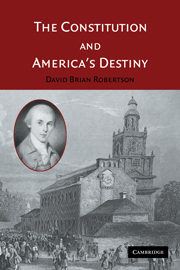Book contents
- Frontmatter
- Contents
- List of Tables and Figures
- Preface
- Acknowledgments
- List of Abbreviations
- 1 Politics and the Constitution
- 2 The Policy Crisis of the 1780s
- 3 James Madison's Plan for the Constitutional Convention
- 4 The Political Landscape of the Constitutional Convention
- 5 Who Governs? Constituting Policy Agency
- 6 What Can Be Governed? Constituting Policy Authority
- 7 How Is the Nation Governed? Constituting the Policy Process
- 8 Our Inheritance: The Constitution and American Politics
- Index
7 - How Is the Nation Governed? Constituting the Policy Process
Published online by Cambridge University Press: 11 November 2009
- Frontmatter
- Contents
- List of Tables and Figures
- Preface
- Acknowledgments
- List of Abbreviations
- 1 Politics and the Constitution
- 2 The Policy Crisis of the 1780s
- 3 James Madison's Plan for the Constitutional Convention
- 4 The Political Landscape of the Constitutional Convention
- 5 Who Governs? Constituting Policy Agency
- 6 What Can Be Governed? Constituting Policy Authority
- 7 How Is the Nation Governed? Constituting the Policy Process
- 8 Our Inheritance: The Constitution and American Politics
- Index
Summary
No matter how cautiously the delegates crafted policy agency and authority, the turbulence of ordinary republican policy making posed an ominous threat to the new government. Any republican policy-making process would nurture vigorous political rivalries. Majorities would rule in the new Congress, as they did in the state legislatures. National lawmakers, just like those in the states, would use all the political methods at their disposal to construct winning coalitions for policies whether good or bad. Because the policy process converted political interests into government action, majority coalitions seeking harmful policy would have to be deterred by the rules for making public policy – if they could be deterred at all. The delegates had to arrange the policy process to make it likely to produce good policies and unlikely to produce bad policies, that is, policies harmful to national interests and their constituencies.
As it grew harder to anticipate the way the new government would work, delegates sought to fortify the institution they believed most likely to defend their particular interests. After the compromise on representation on July 16, the Connecticut delegation and its allies pressed for broad Senate powers because the state-based Senate seemed as likely as the Confederation Congress to defend the economically disadvantaged states. James Madison and his allies, in contrast, pushed for more presidential power because the president seemed the most likely advocate for the nationally minded, forward-looking policy Madison initially envisioned.
- Type
- Chapter
- Information
- The Constitution and America's Destiny , pp. 202 - 235Publisher: Cambridge University PressPrint publication year: 2005



